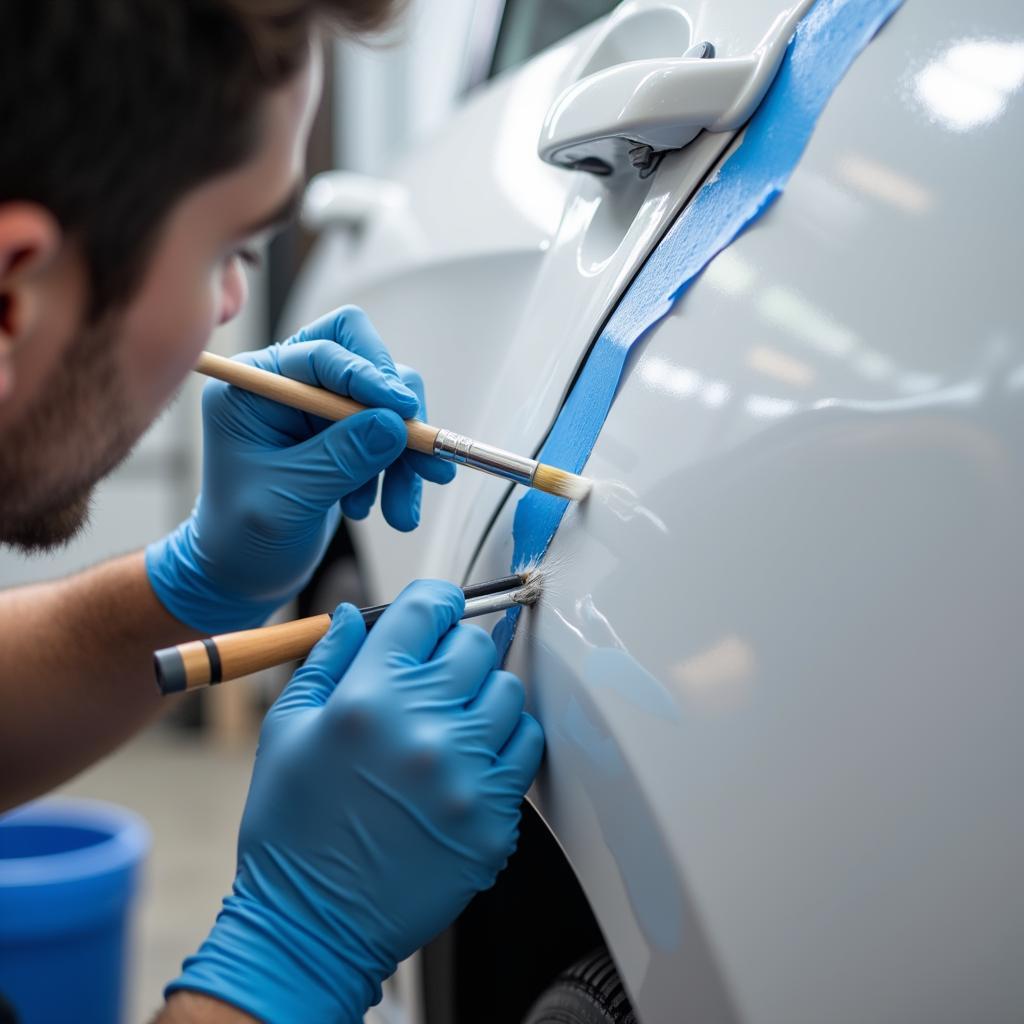Car body paint repairs at home can seem daunting, but with the right knowledge and preparation, you can achieve impressive results and save money. This guide provides a detailed walkthrough of the process, from assessing the damage to applying the final clear coat.
Understanding Your Car’s Paint
Before diving into car body paint repairs at home, it’s crucial to understand your car’s paint system. Most modern cars have a multi-layer system consisting of primer, base coat, and clear coat. Identifying the damaged layers will determine the necessary repair approach. Minor scratches might only affect the clear coat, while deeper ones may expose the base coat or even the primer.
Assessing the Damage: Scratch or Dent?
Accurately assessing the damage is the first step in successful car body paint repairs at home. Is it a light scratch, a deep gouge, or a dent with paint damage? Each scenario requires a slightly different approach. For minor scratches, a simple polishing compound might suffice. Deeper scratches will require touch-up paint, while dents may necessitate filling and sanding before painting.
car body repairs sandy way amington
Gathering Your Materials for Car Body Paint Repairs at Home
Having the right tools and materials will greatly simplify the process and ensure a professional-looking finish. You’ll need items like sandpaper (various grits), masking tape, primer (if needed), touch-up paint, clear coat, polishing compound, rubbing compound, and microfiber cloths. Don’t forget safety gear such as gloves and a respirator.
Essential Tools for a Smooth Finish
- Sandpaper: A variety of grits, from coarse to fine, for smoothing and prepping the surface.
- Masking Tape and Paper: To protect surrounding areas from overspray.
- Applicators: Brushes, spray cans, or foam applicators depending on the repair.
- Polishing and Rubbing Compounds: To restore shine and blend the repair.
car body paint repairs at home dorset
The Step-by-Step Process for Car Body Paint Repairs at Home
- Clean the Area: Thoroughly wash and dry the damaged area to remove dirt and grease.
- Sand the Damaged Area: Use the appropriate grit sandpaper to smooth out scratches or level any raised areas.
- Apply Primer (if needed): If the primer is exposed, apply a thin, even coat of automotive primer.
- Apply Touch-Up Paint: Carefully apply the touch-up paint to the damaged area, ensuring a smooth, even coat.
- Apply Clear Coat: After the touch-up paint has dried, apply a few thin coats of clear coat, allowing each coat to dry before applying the next.
- Sand and Polish: Once the clear coat is dry, use fine-grit sandpaper to smooth out any imperfections. Follow this with polishing and rubbing compounds to restore shine and blend the repair.
 Applying Touch-Up Paint to a Car's Scratched Surface
Applying Touch-Up Paint to a Car's Scratched Surface
Tips for a Professional Finish
- Work in a well-ventilated area: This is essential when working with paints and solvents.
- Apply thin coats: Multiple thin coats are better than one thick coat, which can lead to drips and unevenness.
- Be patient: Allow each coat of paint and clear coat to dry completely before proceeding to the next step.
- Practice on a less visible area: If you’re unsure about your skills, practice on a less conspicuous part of the car first.
“Patience and attention to detail are key to achieving professional-looking results when undertaking car body paint repairs at home,” advises John Smith, an experienced automotive technician with over 20 years in the industry.
car body shop repairs worcester
Conclusion
Car body paint repairs at home can be a rewarding DIY project, saving you money and giving you a sense of accomplishment. By following these guidelines and investing time and patience, you can achieve a professional-looking finish. Remember to assess the damage accurately, gather the necessary materials, and follow the step-by-step process. Don’t rush, and practice makes perfect!
car body repair phillips street industrial estate
FAQ
- Can I repair deep scratches at home? Yes, but it may require more extensive preparation and filling.
- What type of paint should I use? Use automotive touch-up paint that matches your car’s color code.
- How long does it take for the paint to dry? Drying times vary depending on the type of paint and environmental conditions.
- Do I need a clear coat? Yes, a clear coat protects the base coat and provides shine.
- Can I use a hairdryer to speed up the drying process? While not recommended, low heat from a distance can help.
- Where can I find my car’s paint code? The paint code is usually located on a sticker inside the driver’s side doorjamb or in the owner’s manual.
- What if the dent is too deep to repair at home? For significant dents, consult a professional body shop.
Need further assistance? Contact us via WhatsApp: +1(641)206-8880 or Email: [email protected]. Our 24/7 customer support team is always ready to help.
